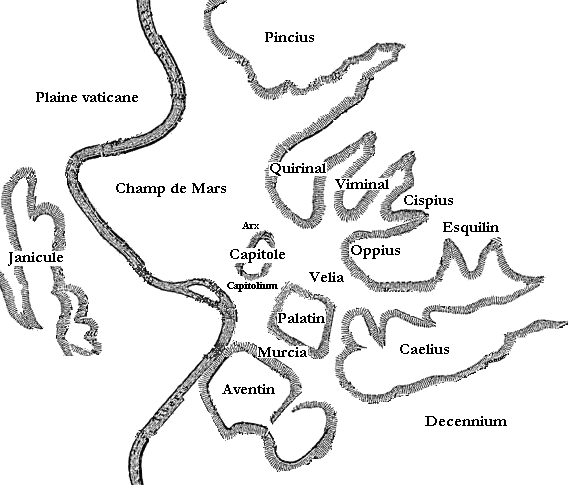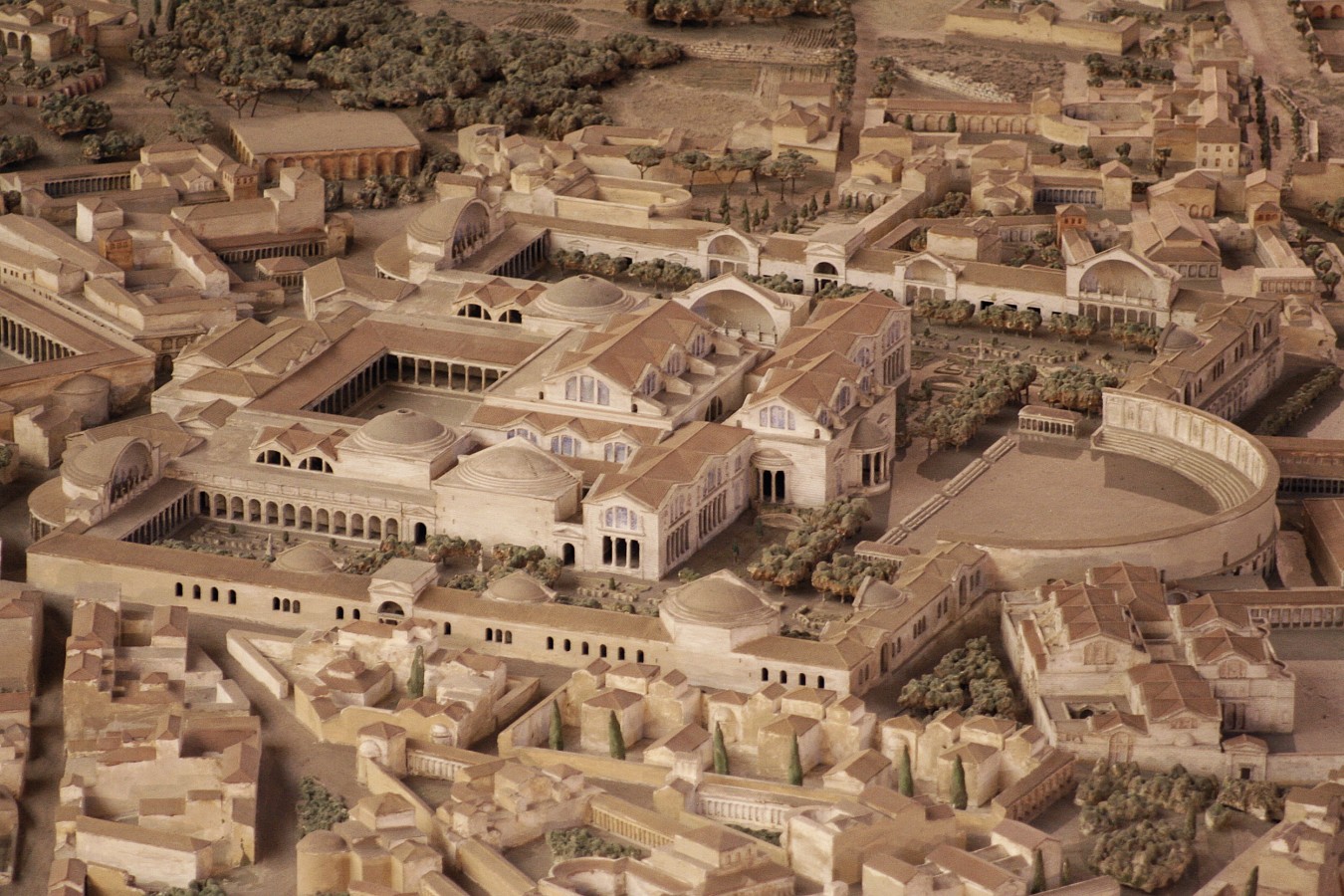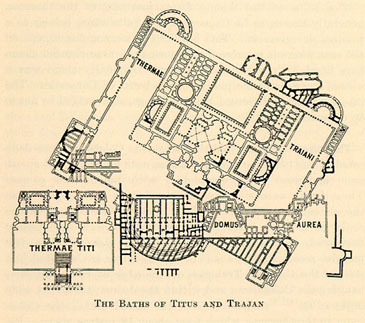|
Oppian Hill
The Oppian Hill (Latin, ''Oppius Mons''; it, Colle Oppio) is the southern spur of the Esquiline Hill, one of the Seven hills of Rome, Italy. It is separated from the Cispius on the north by the valley of the Suburra, and from the Caelian Hill on the south by the valley of the Colosseum. The Oppius and the Cispius together form the Esquiline plateau just inside the line of the Servian Wall. In the divisions of the Septimontium (seven hills) Fagutal appears as an independent locality, which implies that originally "Oppius" was strictly applied to this spur except the western end. The northern tip of this western end was also called Carinae, which extended between the Velian Hill and the Clivus Pullius, looked out to the southwest (across the swamps of the Palus Ceroliae towards the Aventine), incorporated the Fagutal and was one of ancient Rome's most exclusive neighborhoods. At least for religious purposes the name Oppius continued in use to the end of the Roman Republic; n ... [...More Info...] [...Related Items...] OR: [Wikipedia] [Google] [Baidu] |
Rione Monti
Monti is the 1st ''rione'' of Rome, identified by the initials R. I, located in Municipio I. The name literally means "mountains" in Italian and comes from the fact that the Esquiline, the Viminal Hills, and parts of the Quirinal and the Caelian Hills belonged to this ''rione'': currently, however, the Esquiline Hill belongs to the rione Esquilino. The coat of arms consists of three green mountains with three tops on a silver background. History In ancient times, the ''rione'' was densely populated; Monti was home to the Forum Romanum and the so-called ''Suburra,'' where poor people lived, full of disreputable locals and brothels. In the Middle Ages the situation was completely different: the Roman aqueducts were damaged, and it was very difficult to bring water to Monti since it was on the hills. Hence many inhabitants moved to Campus Martius, a lower level part, where they could drink the water from the river Tiber. From the Middle Ages to the beginning of the 19th century ... [...More Info...] [...Related Items...] OR: [Wikipedia] [Google] [Baidu] |
Roman Republic
The Roman Republic ( la, Res publica Romana ) was a form of government of Rome and the era of the classical Roman civilization when it was run through public representation of the Roman people. Beginning with the overthrow of the Roman Kingdom (traditionally dated to 509 BC) and ending in 27 BC with the establishment of the Roman Empire, Rome's control rapidly expanded during this period—from the city's immediate surroundings to hegemony over the entire Mediterranean world. Roman society under the Republic was primarily a cultural mix of Latin and Etruscan societies, as well as of Sabine, Oscan, and Greek cultural elements, which is especially visible in the Roman Pantheon. Its political organization developed, at around the same time as direct democracy in Ancient Greece, with collective and annual magistracies, overseen by a senate. The top magistrates were the two consuls, who had an extensive range of executive, legislative, judicial, military, and religious powers ... [...More Info...] [...Related Items...] OR: [Wikipedia] [Google] [Baidu] |
Baths Of Trajan
The Baths of Trajan ( it, Terme di Traiano) were a massive ''thermae'', a bathing and leisure complex, built in ancient Rome starting from 104 AD and dedicated during the ''kalendae'' of July in 109. Commissioned by Emperor Trajan, the complex of baths occupied space on the southern side of the Oppian Hill on the outskirts of what was then the main developed area of the city, although still inside the boundary of the Servian Wall. The architect of the complex is said to be Apollodorus of Damascus. The baths were being utilized mainly as a recreational and social center by Roman citizens, both men and women, as late as the early 5th century. The complex seems to have been deserted soon afterwards as a cemetery dated to the 5th century (which remained in use until the 7th century) has been found in front of the northeastern exedra. The baths were thus no longer in use at the time of the siege of Rome by the Ostrogoths in 537; with the destruction of the Roman aqueducts, all ''thermae' ... [...More Info...] [...Related Items...] OR: [Wikipedia] [Google] [Baidu] |
Nero
Nero Claudius Caesar Augustus Germanicus ( ; born Lucius Domitius Ahenobarbus; 15 December AD 37 – 9 June AD 68), was the fifth Roman emperor and final emperor of the Julio-Claudian dynasty, reigning from AD 54 until his death in AD 68. He was adopted by the Roman emperor Claudius at the age of 13 and succeeded him on the throne. Nero was popular with the members of his Praetorian Guard and lower-class commoners in Rome and its provinces, but he was deeply resented by the Roman aristocracy. Most contemporary sources describe him as tyrannical, self-indulgent, and debauched. After being declared a public enemy by the Roman Senate, he committed suicide at age 30. Nero was born at Antium in AD 37, the son of Gnaeus Domitius Ahenobarbus and Agrippina the Younger, a great-granddaughter of the emperor Augustus. When Nero was two years old, his father died. His mother married the emperor Claudius, who eventually adopted Nero as his heir; when Cla ... [...More Info...] [...Related Items...] OR: [Wikipedia] [Google] [Baidu] |
Domus Aurea
The Domus Aurea (Latin, "Golden House") was a vast landscaped complex built by the Emperor Nero largely on the Oppian Hill in the heart of ancient Rome after the great fire in 64 AD had destroyed a large part of the city.Roth (1993) It replaced and extended his Domus Transitoria that he had built as his first palace complex on the site. History The Domus Aurea was probably never completed. Otho and possibly Titus allotted money to finish at least the structure on the Oppian Hill; this continued to be inhabited, notably by emperor Vitellius in 69 but only after falling ill, until it was destroyed in a fire under Trajan in 104. A symbol of decadence that caused severe embarrassment to Nero's successors, the Domus Aurea was stripped of its marble, jewels, and ivory within a decade. Although the Oppian villa continued to be inhabited for some years, soon after Nero's death other parts of the palace and grounds, encompassing 2.6 km2 (c. 1 mi2), were filled with earth a ... [...More Info...] [...Related Items...] OR: [Wikipedia] [Google] [Baidu] |
Marble Sculpture
Marble has been the preferred material for stone monumental sculpture since ancient times, with several advantages over its more common geological "parent" limestone, in particular the ability to absorb light a small distance into the surface before refracting it in subsurface scattering. This gives an attractive soft appearance that is especially good for representing human skin, which can also be polished. Of the many different types of marble the pure white ones are generally used for sculpture, with coloured ones preferred for many architectural and decorative uses. The degree of hardness is right to carve without too much difficulty, but still give a very durable result, if not exposed to acid rain or seawater. Famous individual types and quarries include from classical times Parian marble from Paros, used for the ''Venus de Milo'' and many other Ancient Greek sculptures, and Pentelic marble, from near Athens, used for most of the Parthenon sculptures, and by the Roma ... [...More Info...] [...Related Items...] OR: [Wikipedia] [Google] [Baidu] |
Raffaele De Vico
Raffaele () is an Italian given name and surname, variant of the English Raphael. Notable people with the name include: Given name *Raffaele Amato, Italian mobster *Raffaele Cutolo, Italian mobster *Raffaele Ganci, Italian mobster *Raffaele Cantone, Italian magistrate *Raffaele De Rosa, Italian motorcycle racer * Raffaele Di Paco, Italian cyclist *Raffaele Fitto, Italian politician *Raffaele Guariglia, Italian politician *Raffaele Lombardo, Italian politician *Raffaele Palladino, Italian footballer *Raffaele Pinto, Italian racing driver *Raffaele Pisu, Italiano actor *Raffaele Riario, Italian cardinal *Raffaele Rossetti, Italian politician *Raffaele Carlo Rossi, Italian cardinal *Raffaele Viviani, Italian artist *Raffaele Contigiani (1920–2008), Italian architect Surname * Virginia Raffaele, Italian actress See also * Raphael (other) * Rafael (other) * San Raffaele (other) * Raffaello (other) Raffaello, Raffaele or Raffaellino is an Italian ... [...More Info...] [...Related Items...] OR: [Wikipedia] [Google] [Baidu] |
Capture Of Rome
The Capture of Rome ( it, Presa di Roma) on 20 September 1870 was the final event of the unification of Italy (''Risorgimento''), marking both the final defeat of the Papal States under Pope Pius IX and the unification of the Italian Peninsula (except San Marino) under the Kingdom of Italy. The capture of Rome by the Italian Army brought an end to the Papal States, which had existed since 756, and the temporal power of the Holy See, and led to the establishment of Rome as the capital of unified Italy. It is today widely commemorated throughout Italy, with the ''Via XX Settembre'' street name in a considerable number of localities. Background During the Second Italian War of Independence, much of the Papal States had been conquered by the Kingdom of Sardinia under King Victor Emmanuel II, who became King of Italy#Independent Kingdom of Italy, House of Savoy (1861–1946), King of Italy upon the proclamation of the Kingdom of Italy on 17 March 1861. The new state still had not i ... [...More Info...] [...Related Items...] OR: [Wikipedia] [Google] [Baidu] |
Plebeian
In ancient Rome, the plebeians (also called plebs) were the general body of free Roman citizens who were not patricians, as determined by the census, or in other words " commoners". Both classes were hereditary. Etymology The precise origins of the group and the term are unclear, but may be related to the Greek, ''plēthos'', meaning masses. In Latin, the word is a singular collective noun, and its genitive is . Plebeians were not a monolithic social class. Those who resided in the city and were part of the four urban tribes are sometimes called the , while those who lived in the country and were part of the 31 smaller rural tribes are sometimes differentiated by using the label . (List of Roman tribes) In ancient Rome In the annalistic tradition of Livy and Dionysius, the distinction between patricians and plebeians was as old as Rome itself, instituted by Romulus' appointment of the first hundred senators, whose descendants became the patriciate. Modern hypotheses date ... [...More Info...] [...Related Items...] OR: [Wikipedia] [Google] [Baidu] |
Gens
In ancient Rome, a gens ( or , ; plural: ''gentes'' ) was a family consisting of individuals who shared the same Roman naming conventions#Nomen, nomen and who claimed descent from a common ancestor. A branch of a gens was called a ''stirps'' (plural: ''stirpes''). The ''gens'' was an important social structure at Rome and throughout Roman Italy, Italia during the period of the Roman Republic. Much of individuals' social standing depended on the gens to which they belonged. Certain gentes were classified as Patrician (ancient Rome), patrician, others as plebs, plebeian; some had both patrician and plebeian branches. The importance of membership in a gens declined considerably in Roman Empire, imperial times, although the ''gentilicium'' continued to be used and defined the origins and Roman dynasty, dynasties of Roman emperors. Harper's Dictionary of Classical Antiquities, ''Harper's Dictionary of Classical Literature and Antiquities'', Second Edition, Harry Thurston Peck, E ... [...More Info...] [...Related Items...] OR: [Wikipedia] [Google] [Baidu] |
Veii
Veii (also Veius; it, Veio) was an important ancient Etruscan city situated on the southern limits of Etruria and north-northwest of Rome, Italy. It now lies in Isola Farnese, in the comune of Rome. Many other sites associated with and in the city-state of Veii are in Formello, immediately to the north. Formello is named after the drainage channels that were first created by the Veians. Veii was the richest city of the Etruscan League. It was alternately at war and in alliance with the Roman Kingdom and later Republic for over 300 years. It eventually fell in the Battle of Veii to Roman general Camillus's army in 396 BC. Veii continued to be occupied after its capture by the Romans. The site is now a protected area, part of the Parco di Veio established by the regional authority of Lazio in 1997. Site City of Veii The city of Veii lies mainly on a tuff plateau in area. The Valchetta flows a few miles eastward to join the Tiber River on the south side of Labaro ... [...More Info...] [...Related Items...] OR: [Wikipedia] [Google] [Baidu] |





